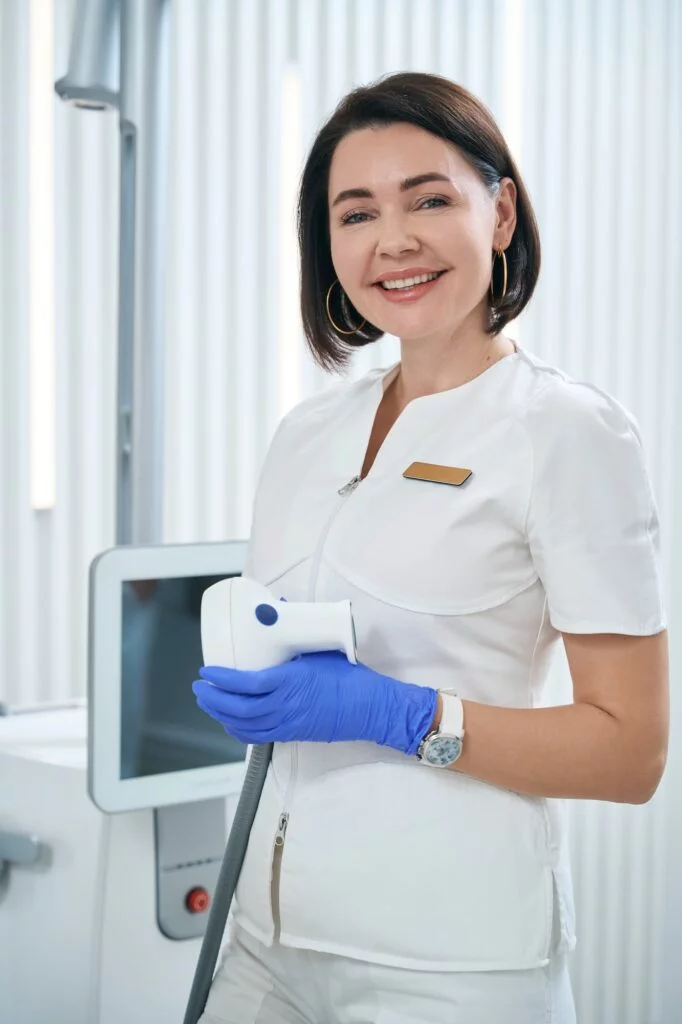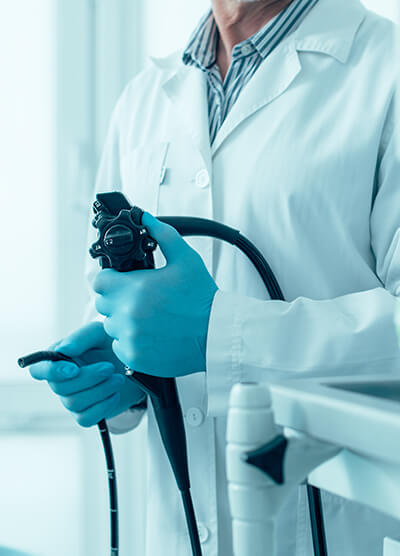Reduce Your Risk of Cancer
What Is a Colonoscopy?
A colonoscopy is a procedure used most commonly to screen for colon cancer and/or to identify and correct bleeding problems. It is also used to evaluate persistent diarrhea, abdominal pain, and changes in bowel habits. A colonoscope is a long, thin, and flexible tube with a tiny video camera that projects real-time images of the inside of colon onto a monitor. The device is also used to inflate or deflate the colon, use small instruments during the procedure, as well as flush water into an area.
A colonoscopy is usually an outpatient procedure that a gastroenterologist performs at an endoscopy center. During a colonoscopy, your gastroenterologist might perform any number of tasks depending on findings. These include taking photos to document findings, sampling tissues to submit to a lab for biopsies, removing precancerous polyps, dilating areas of intestinal narrowing, or stopping bleeding.
You will receive intravenous sedation during a colonoscopy, so you are essentially asleep during the entire procedure.
Uses of Colonoscopy
Colonoscopies are an important way to check for colon cancer and to remove abnormal growths on the inside lining of the colon. These polyps vary in size and shape and usually cause no symptoms. A physician is unable to predict whether a polyp is malignant or not by visual appearance alone. Since most instances of colon cancer start out as benign polyps years before cancer develops, the best strategy to prevent colon cancer is to perform periodic colonoscopies to locate and remove polyps. The technique of removing polyps during a colonoscopy is called a polypectomy.
Your gastroenterologist can limit insertion to the lower part of the large intestine (rectum, sigmoid, and descending colon). This limited insertion is called flexible sigmoidoscopy. Alternatively, your GI physician could advance the scope through and beyond the colon and into the last part of the small intestine called the terminal ileum. The length of colon/small intestine to examine depends on the reason for performing the procedure.
How Do I Prepare for My Colonoscopy?
The office will provide you with detailed instructions on how to prepare for your colonoscopy, including how to thoroughly clean out the colon. This clean-out tends to be somewhat tedious and unpleasant, but most patients tolerate this without major problems. The success of your colonoscopy will depend on how well your bowel is cleaned out beforehand. A colon with residual stool can’t be optimally inspected.
Various methods can be used to help cleanse the bowel, and your doctor will recommend what they prefer in your specific case. A clear liquid diet is taken for part or all day prior to the colonoscopy. Most typically, the patient will drink a liquid preparation that will stimulate bowel movements beginning the evening prior to the procedure. The prep is typically split into different portions to keep it more tolerable to take as well as to better clean out the upper end (right side) of colon. A better view of the right side of the colon is crucial, because flatter, more subtle polyps commonly develop there. Whichever clean-out methods are recommended for you, be sure to follow instructions as directed.
Follow Directions
Carefully review instructions you have been given about what to eat or drink the day before your colonoscopy, as well as what time to stop consuming all foods and fluids. You should receive specific instructions about what medications to continue, stop, or modify prior to and through the day of the procedure. This is especially important for patients who take blood thinners, diabetic medications, and blood pressure drugs. A colonoscopy is usually performed at an outpatient endoscopy/surgery center or sometimes at the outpatient section of a hospital. You’ll get specific instructions about where to go and when to arrive. After registering and presenting insurance information and (if needed) insurance pre-authorization forms, you will sign a form that verifies your consent to having the procedure and that you understand what is involved. If anything is unclear, be sure to ask for more information and clarification.
How Is the Colonoscopy Performed?
First, you will change into a patient gown. Don’t wear makeup or bring unnecessary jewelry to the endoscopy center. During the procedure, we emphasize patient safety and comfort. A nurse or anesthesiologist will insert an IV line and administer medication to make you sleepy and relaxed during the procedure. Once you are adequately sedated, your doctor will first do a digital rectal exam with a gloved, lubricated finger followed by insertion of the lubricated colonoscope. The time needed for a colonoscopy will vary, depending in part on what is found and what actions are performed. On average, the procedure takes about 30 minutes.
Most patients wake up after the procedure having experienced no discomfort and with zero recollection of the procedure at all.
Afterward, our nursing staff will monitor and care for you in a recovery area until the effects of the sedation medication wear off. At that time, your doctor will inform you about the results of your colonoscopy and provide any additional information you need to know. We will also provide you with instructions regarding how soon you can eat and drink, plus other guidelines on resuming your normal routine. Before you leave, we will give you a copy of your colonoscopy report with photos and will forward a copy to your referring physician. We will send any tissue specimens removed during the colonoscopy to the lab for a pathologist to analyze.
How Is the Colonoscopy Performed?
You will need to arrange for someone to drive and take you home after your colonoscopy. Travel by taxi, Uber, bus, or ride share is typically NOT allowed after procedures and treatments requiring sedation. You can typically resume a normal diet and your normal medications after you leave the facility. Sometimes, after colon polyp removal, your physician might request that you delay restarting blood thinners for a specified time to prevent bleeding. You can usually resume light activities on the day of the colonoscopy. You can drive the day after. Occasionally, bloating, gas, or mild cramping may occur after a colonoscopy, which should go away on its own within 24 hours.
After Your Colonoscopy
What Are the Risks of a Colonoscopy?
What Are My Alternatives to This Procedure?
Although a colonoscopy is considered to be the gold standard to diagnose colon cancer and to diagnose and remove precancerous polyps, some patients prefer less invasive options. Since colon cancer is the second-most common cause of cancer death, it is always better to do some kind of screening than nothing at all.
These alternatives include two kinds of fecal tests. A FIT test, used to detect subtle traces of blood, must be done yearly to have much value. Cologuard® does the same, plus it can detect genetic material of cancer.
Another option is a CT scan of the colon, often referred to as a virtual colonoscopy or CT colonography.
A sigmoidoscopy is another option. It is essentially an abbreviated colonoscopy in which your doctor examines just the lower quarter or third of the colon using a shorter colonoscope. This procedure is best for those with a low risk for colon cancer, such as those with no family history and no previous polyps.
A capsule endoscopy is available, although it is not generally recommended as an alternative to a colonoscopy.
Note that any positive result on an alternative test must be followed-up with a colonoscopy. All of the alternative screening options mentioned above can miss polyps or cancer – produce a false negative result – or may indicate a positive result when nothing is wrong (a false positive). Consult with your gastroenterologist if you have questions about the accuracy of any of these diagnostic tests.
What About Insurance Coverage?
Medicare and almost all private insurance, including HMOs, cover colonoscopies for colon cancer screening with no co-pay or deductible. Follow-up exams after polyp removal usually do have some co-pay or deductible. Fecal blood tests are usually covered, Cologuard is sometimes covered, and a CT colonography is rarely covered. Capsule endoscopies are not yet covered.
Schedule your next colonoscopy by contacting the location nearest you.




